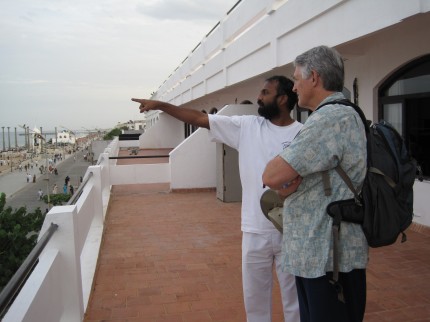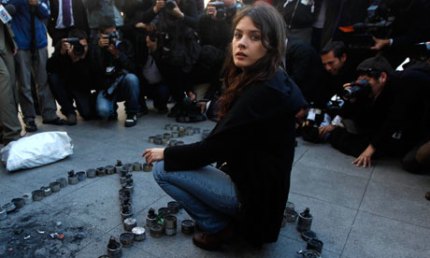Integral Education
Integral education is the philosophy and practice of teaching children holistically. It was pioneered by the Mother and Sri Aurobindo. The Mother took Sri Aurobindo’s philosophies and brilliantly turned them into an educational structure and curriculum. This curriculum is what is used at the Sri Aurobindo Society International Center of Education.
We received a presentation about integral education from Shivakumar, the society’s master logistician and society director Vijaybai’s right hand person.
 Shivakumar pointing The Way
Shivakumar pointing The Way
This post is a long one, but please read it, as these ideas have deeply inspired me. This philosophy would revolutionize the way we teach our children, and thus the way we develop our citizens who will shape our collective future. There has to be a way to incorporate some of these ideas into the mainstream in a cost-effective way…But in my excitement I’m getting ahead of myself.
Integral education is the idea that children should be taught more than how to read and write, add and subtract. They should be taught to develop their character and their physical selves in conjunction with their intellectual growth.
What follows are the basic principles of integral education.
There are four life stages: birth, growth, decay, and death/return.* We cannot control when or where we are born or when we die, but we can influence the stages of growth and decay. The moment we stop growing, we begin the stage of decay. All education should be focused on supporting growth.
*Return is included in death because when we are born we have come from somewhere, and we do not leave when we die, only go onto something else.
All beings have an innate knowledge of how to grow and decay. How does a plant know when to sprout? They do not go to school to grow leaves and roots. Plants have an inbuilt knowledge. All a plant needs is a little protection in the early stages of its life. Who taught a fish to swim? Or a peacock to dance when it rains? Don’t you think that the same inbuilt knowledge lies in more developed beings like humans?
 Shivakumar’s sketches, with the Mother watching over us in the background
Shivakumar’s sketches, with the Mother watching over us in the background
Three Bodies
Now integral education says that we all have not one but three bodies. First, there is the physical body, which needs proper food and exercise to grow. Second, we have a mental body, which needs intellectual stimulation, new facts, skills, ideas, and puzzles to be developed. And thirdly, we have the emotional, or vital, body. What type of food does the emotional body need to grow healthily? A child needs love, security, and to feel valued to have a healthy emotional being. Everything we teach our children st not just be stimulating intellectually, but it must be taught with a loving heart.
The emotional body has certain qualities, or values. These are values like courage, truthfulness, sincerity, love, compassion, etc. Just like physical exercises, these qualities need to be developed and exercised. By growing the positive qualities in oneself, the negative ones automatically decay. If we foster compassion in a child, aggression naturally fades away. But how do we put emotional education into practice? Emotions cannot be taught, right? Students must be prompted to look within themselves and learn to analyze their emotions through experiences.
For example, two boys who are friends get in a fight on the playground. The teacher is nearby but does not stop them. One of the boys runs up to the teacher crying and complaining. Instead of reprimanding the boy about how it is bad to punch people, the teacher asked,
“How do you feel?”
“Terrible!” he said.
The teacher asked, “Well what do you want to do?”
“He is my best friend, I don’t want to fight! I want to be friends again!”
The teacher pulled two candies out of her pocket and said,
“Here, then go and do it.”
With the teacher’s words of encouragement, that is what the boy did. Reprimand and timeouts only promote the recognition of negative emotions and behavior. This mentality teaches a child how to listen to his heart.
The emotional body is so important because it has a major influence on the physical and the mental body. We can clearly see that we have three bodies when we have to make tough decisions, and our three bodies compete against each other. Has your physical body ever kept you up late at night because your heart and your logical mind are split in two different places? This is a negative phenomenon to avoid. Ideally, integral education teaches how to develop and control each body will integrating them together as one.
In the West, we value the mind and the physical body, but we do not nurture the emotional body. We do not think about what food it needs beyond some surface pleasures of art, beauty, and music. The emotional body is what should guide us and will push us to treat each other with love and respect. It is called the vital emotional body for a reason, without it we would not be human. In India the mind is considered imperfect, as it has many limitations. It can incorrectly interpret what comes out of the soul, trying to squeeze a vibration through the lens of logic. A complete person is one who has a brilliant mind, a strong body, and a giant heart. This is the aim of integral education.
Practical Implementation
But how do we put these theories into practice? How does a teacher write a curriculum based on this model?
Schools need to be clean and beautiful. Teachers should be strong and loving. Surround students with positive and beautiful sights, sounds, and vibrations, and the child will be nurtured properly. When the child goes into the outside world and encounters negative vibrations, pollution, alcoholism, or racism, the child will recognize these things as negative.
The curriculum is modeled after the stages of a child’s development. This first stage is physical development, years 0-5. When a child is born, the ears are the first thing to open up, then the eyes. Thus, sensory training is done to develop each sense, one by one. The physiology of eating, sleeping and going to the toilet also must be taught. Some aspects of the emotional body are taught, but they are still growing. Children at this stage are filled with positive vibrations; they love to laugh, be loud, and they can respond very well emotionally to stories.
The second stage takes place typically between the ages of 7 and 14, and is focused on emotional development. Children must continue to be fed with positive emotions. Logic does not work, nor rational thoughts. Children at this age period are rebellious. If you tell them not to do something they will do it. Thus, teaching should be done through an emotional lens. Bullying is wrong because it makes one feel bad. Lying is bad because it hurts oneself. Teachers should ask students “how do you feel?” Values cannot be taught, only nurtured and modeled.
Onwards, more priority can be given to the the intellectual body, in balance with physical activity and emotional development. Students should be given the knowledge that they can handle. Teaching about WWII or the current slave trade should be done only if the child can handle it emotionally. You would not give a child a 1,000 kilogram to lift on her shoulders, but a kilogram or half a kilogram, she can do it.
So there you have it folks. Phew. The idea of integral education can also be used for management and other leadership.
For further reading check out:
Integral Education: A Foundation for Our Future (by Partho)
Integral Management (Sri Aurobindo Foundation for Integral Management)
Integral Education: in practice at the ashram
http://www.sriaurobindosociety.org.in/activity/educate.htm#safier
 (Photograph: Roberto Candia/AP)
(Photograph: Roberto Candia/AP)


